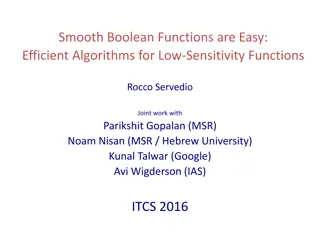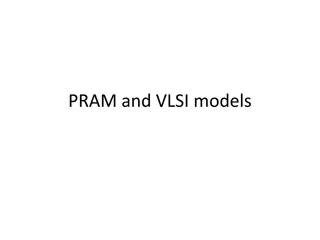
Understanding PRAM Algorithms and Models for Parallel Computing
Learn about PRAM (Parallel Random Access Machine) algorithms and models for designing parallel programs effectively. Explore different PRAM models, mapping between models, and examples like binary tree reduction and merging sorted lists. Understand the concepts of EREW, CREW, CRCW, and the steps involved in PRAM algorithms.
Uploaded on | 0 Views
Download Presentation

Please find below an Image/Link to download the presentation.
The content on the website is provided AS IS for your information and personal use only. It may not be sold, licensed, or shared on other websites without obtaining consent from the author. If you encounter any issues during the download, it is possible that the publisher has removed the file from their server.
You are allowed to download the files provided on this website for personal or commercial use, subject to the condition that they are used lawfully. All files are the property of their respective owners.
The content on the website is provided AS IS for your information and personal use only. It may not be sold, licensed, or shared on other websites without obtaining consent from the author.
E N D
Presentation Transcript
PRAM Algorithms Sathish Vadhiyar
PRAM Model - Introduction Parallel Random Access Machine Allows parallel-algorithm designers to treat processing power as unlimited Ignores complexity of inter-process communication Consists of control unit, global memory, and an unbounded set of processors, each with own private memory An active processor reads from global memory, performs computation, writes to global memory Execute in SIMD model PRAM algorithm can be a suitable basis for the design of a parallel program targeted to a real machine
Different Models Various PRAM models differ in how they handle read or write conflicts 1. EREW Exclusive Read Exclusive Write 2. CREW Concurrent Read Exclusive Write 3. CRCW 1. COMMON All processors writing to same global memory must write the same value 2. ARBITRARY one of the competing processor s value is arbitrarily chosen 3. PRIORITY processor with the lowest index writes its value
Mapping Between Models Any PRAM model/algorithm can execute any other PRAM model/algorithm For example, possible to convert PRIORITY PRAM to EREW PRAM When Pi in the priority PRAM accesses Mj, Pi in the EREW PRAM algorithm writes (j,i) in another memory location Ti Then the EREW PRAM algorithm sorts the elements of T
Mapping Between Models P1 reads T, retrieves (i1, j1) and writes a 1 into another memory location Sj1 The remaining processors, Pk, reads Tk and Tk- 1. If ik not equals ik-1, then Pk writes a 1 into Sjk. Else writes 0 Elements of s with value 1 correspond to the highest priority processor
Steps in PRAM Algorithm & Example: Reduction PRAM algorithms have two phases: Phase 1: Sufficient number of processors are activated Phase 2: Activated processors perform the computations in parallel For example, binary tree reduction can be implemented using n/2 processors EREW PRAM suffices for reduction
Example: Merging Two Sorted Lists Most PRAM algorithms achieve low time complexity by performing more operations than an optimal RAM algorithm For example, a RAM algorithm requires at most n-1 comparisons to merge two sorted lists of n/2 elements. Time complexity is O(n) CREW PRAM algorithm: Assign each list element its own processor n processors
Example: Merging Two Sorted Lists The processor knows the index of the element in its own list Finds the index in the other list using binary search Adds the two indices to obtain the final position The total number of operations had increased to O(nlogn) Not cost-optimal
Example: Enumeration sort Computes the final position of each element by comparing it with the other elements and counting the number of elements having smaller value A special CRCW PRAM can perform can perform the sort in O(1) time Spawn n2 processors corresponding to n2 comparisons Special CRCW PRAM If multiple processors simultaneously write values to a single memory location, the sum of the values is assigned to that location
Example: Enumeration sort So, each processor compares a[i] and a[j]. If a[i] < a[j], writes position[i] = 1, else writes position[i]=0 So the summation of all positions will give the final position constant time algorithm But not cost-optimal takes O(n2) comparisons, but a sequential algorithm does O(nlogn) comparisons
Summary PRAM algorithms mostly theoretical But can be used as a basis for developing efficient parallel algorithm for practical machines Can also motivate building specialized machines









